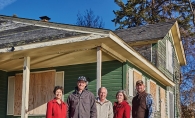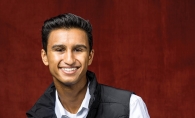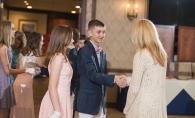Once upon a time, a bare ankle might have given rise to a scandal. A dancer performing without a corset might have caused a scene. Louise Indritz recalls a time when even ballet roused audiences’ objections. So when some people look askance at her Middle Eastern dance classes (also known as belly dancing), Indritz is fully aware that many art forms have met with a chorus of objections. “For a long time, ballet was considered scandalous,” she says. “Many dance forms have had opinions thrust upon them.” But misconceptions surrounding belly dancing don’t prevent Indritz from teaching and performing the art form. “We break down [judgments] by saying, ‘It’s dance,’ ” she adds.
Indritz teaches two levels of belly dance through Minnetonka Community Education: beginner and level 2 (plus a summer mixed-level class). The weekly 90-minute sessions attract a diverse group, featuring all ages (one session included students from age 9 to age 70) and abilities, and even mother-daughter duos. Classes feature stretching techniques, isolation exercises (to help students focus on one muscle group or part of the body), dance moves across the floor, and the addition of veils and finger cymbals.
“I think people really don’t understand what it is unless they’ve tried it,” student Judith Benka says. After taking swing and ballroom dance classes, Benka decided three years ago to give belly dancing a whirl. She’s developing her core strength, balance, flexibility and so much more. “It’s just a great opportunity to improve balance and posture, strengthen your core, have fun with jingles, and meet new people,” Benka notes. She feels at ease in the classes. “No one is judging,” she says. “We laugh at ourselves.” Benka attributes the classroom’s supportive vibe to Indritz. “She is so enthusiastic and welcoming,” Benka says. “She nurtures people.”
Indritz understands what it means for students to reach out of their comfort zones, explaining that her intention to attend a belly dance class in 2000 was purely fitness-driven. There was a hint of hesitancy on her part at the time. She was in her 40s, and that phase of life included some mental roadblocks. “You get in the mindset of ‘I’m O-L-D,’ ” she explains, but “the gym didn’t appeal to me.” Undeterred, onward she went for her initial foray into Middle Eastern dance. “I went for exercise, and I’ve never looked back,” she says. “It’s been a marvelous experience.”
Not only did Indritz’s body reap the benefits of dance, but her spirit also received encouragement. “I was really inspired,” she says. “To be able to do the movements was a big deal to me.” Indritz says that belly dance gives her a sense of empowerment, and permission to move her body in ways that might have made her feel hesitant in the past. “This dance is something you do for your body and for your heart,” Indritz says. Her newfound pastime led her to study with Cassandra Shore, the founder and artistic director of Jawaahir Dance Company in Minneapolis. Indritz’s dance history also includes ballet, Bharatanatyam (the classical dance style of India), modern and Latin dance. She performs at small venues with the semi-professional Sisters of the Sahara. While Indritz enjoys teaching and performing, she continues to take classes to refine her skill set and seek out new avenues of self-expression. “It’s a never-ending journey,” she says.
Community Education
Louise Indritz touts the importance of community education for all ages in the lake area. “It’s extremely important,” she says. “Community education reminds us that our brain continues to learn if we give it something to do,” Indritz says. “It encourages and increases the value of the community.” Student Judith Benka adds, “This is a great resource for the community, and I have taken several other courses through them, including swing and ballroom dancing, hoop dancing, yoga, bridge and artisan breadmaking.”









